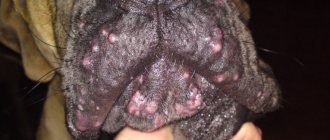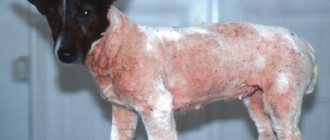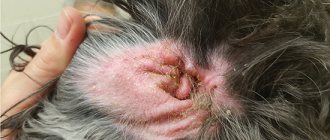Symptoms, types and treatment of allergies in Spitz
The Pomeranian's body, like any other living creature, is prone to various diseases, one of which is an allergic reaction.
Allergies in a Spitz can be caused by: If you identify characteristic symptoms of an allergic reaction, it is important to seek help from a veterinarian.
The Pomeranian Spitz requires good care; you can read how to properly care for your pet here, including the need for timely medical care, even if such a seemingly minor pathology as an allergy is detected.
Allergies in Spitz - symptoms and causes
You can understand that your pet has an allergy by the following signs that appear in the dog, regardless of the type of allergen:
If allergy therapy is not carried out in a Spitz, the pet will experience the following symptoms:
With some types of allergies, including respiratory ones, symptoms may develop, the occurrence of which requires immediate contact with a veterinary clinic. These signs include:
An owner who wants to understand how allergies manifest in a Spitz should remember that the pet can experience all of the above symptoms, as well as some of them.
The cause of an allergy is an allergen that affects the body from outside or inside it, and causes a protective reaction of the immune system. Depending on the cause, allergic reactions are divided into several types.
Pomeranian allergy
Many people would like to have a dog, but for various reasons they cannot afford it. One of these reasons may be allergies, both in adults and children.
Small dog breeds , such as the Pomeranian, are very popular among the entire population of the globe.
In this article we will try to figure out whether people are allergic to Spitz, why it can occur and how it can be avoided.
Allergies to dogs can manifest themselves in the following types:
- allergic rhinitis : sneezing, nasal discharge, itching and nasal congestion;
- allergic conjunctivitis : itching, lacrimation, puffiness, redness of the eyes;
- bronchial asthma : dry cough, difficulty breathing, shortness of breath or suffocation;
- urticaria : itching, skin rashes.
All pets can cause an allergic reaction, which can be congenital or acquired. And sometimes, a person does not suspect for many years that he has it until a pet appears in the house. It is advisable, before getting a dog of a certain breed, and in particular a Spitz, to communicate with him more often: with friends, in a kennel or visit an exhibition. If there is an allergy, it should usually appear within two hours.
What to do if you are allergic to a dog
If you experience symptoms of illness when a Pomeranian appears in your home, then it is easy to determine the cause. All you have to do is isolate your pet for a while, giving it, for example, to friends. If the signs of the disease disappear in the absence of the animal, then there is no doubt who is the source of the allergic reaction.
To treat dog allergies you need to:
- contact allergists and undergo certain tests to identify the causes of the disease and choose treatment methods;
- undergo a course of treatment;
- keep the premises clean;
- carry out preventive measures to strengthen the immune system;
- provide quality care for a pet living in the same house with an allergy sufferer.
If a repeated allergic reaction occurs, despite carrying out all the recommended procedures, you will need to think about the fact that, most likely, you will be forced to part with the dog.
Precautions that can reduce the chances of allergies
If the allergy is mild, a number of measures can be taken to prevent it:
- carry out daily wet cleaning of the house;
- remove all “dust collectors” - carpets or replace them with hypoallergenic ones;
- systematically comb and wash the dog, as pets carry pollen on their fur;
- do not allow your Spitz to sleep in the same bed with you, and also prohibit his stay on sofas and upholstered furniture;
- If dandruff appears in a Spitz, carry out treatment;
- raise your pet correctly, stop barking uncontrollably and master at least minimal training methods;
- wash your hands thoroughly after handling an animal;
- Buy a good and proven air purifier.
Hypoallergenic dog breeds
There are some similar signs by which dogs that are least allergic can be grouped into three groups , these are:
- pets that do not shed at all;
- breeds that shed a little;
- dogs that do not suffer from skin diseases: hairless and smooth-haired.
These are mainly representatives of small breeds of dogs.
Food allergies in Spitz
An allergic reaction in a dog can occur due to an incorrect diet; our other article will tell you how to properly feed a Spitz. Often, allergies are a consequence of feeding low-quality dry food containing a large amount of dyes, various flavor enhancers and additives. An excessive amount of protein can also cause allergy symptoms in Spitz dogs.
An allergic reaction can occur not only to industrial food, but also to natural food. Particular care should be taken when introducing foods that belong to a high risk group into the Pomeranian menu:
An allergic reaction can also be caused by a mixed feeding method. If an animal has a food allergy, you need to identify the product that served as the allergen and remove it from the menu. However, the danger lies in the risk of swelling of the larynx and face of the Pomeranian, so you should be especially careful about the pet’s condition.
Pomeranian allergy
An allergy to dogs has symptoms such as itching, shortness of breath, runny nose, redness of the skin and eyes, and in some cases a sharp increase in temperature.
There are no completely hypoallergenic dogs, and the Pomeranian is no exception. But each person is individual and allergies do not occur in everyone.
In this article we will look at what causes an allergic reaction and whether there are ways to avoid it.
Source of the disease
Allergies to dogs can be either congenital or acquired. If in the first case the allergic reaction appears immediately, then in the second it can become an unpleasant surprise. After checking the allergy tests, if they are positive, doctors prohibit any contact with dogs.
Many people are mistaken in believing that allergies arise from animal fur, but this is not the case. The coat of the Pomeranian Spitz is just a carrier of irritants such as dust and pollen from flowers.
Skin mites can also cause allergies, or more precisely, their metabolic products in the upper layer of the skin - a specific protein.
A dog's dandruff and saliva can also cause the disease.
Is a Spitz hypoallergenic?
Due to its small size, the Pomeranian brings in fewer allergic irritants from the street. It also produces little specific protein. But being a dominant dog, the Pomeranian barks a lot and produces a lot of saliva, which can cause an allergic reaction.
Another advantage of the Pomeranian is that it has long and fluffy hair, so during seasonal shedding, dead hairs are retained on the dog. They can be removed by brushing the Pomeranian.
Important Rules
To understand whether a person is allergic to a Pomeranian, you need to be near him for a couple of hours. If after this time no symptoms of an allergic reaction have appeared, then the Pomeranian is suitable as a pet.
If a reaction does occur, then it is necessary to stop all communication with the dog. But if the desire to have such a pet outweighs the risk of an allergic reaction, then you need to follow several important rules, thanks to which you can minimize this risk:
- cleaning;
- prohibition for pets on sofas and beds;
- bathing the dog;
- brushing the dog;
- treating your pet for dandruff if present;
- training;
- purifier installation.
Let's look at each point in more detail. To reduce the risk of allergies in the owner of a Pomeranian, it is necessary to regularly clean the house. Preferably every other day or maximum two days.
Clean the surfaces of the floor, sofas, armchairs and everything else with a vacuum cleaner. Do wet cleaning of furniture surfaces. When your Pomeranian starts shedding seasonally, you need to clean it daily.
It is also necessary to ventilate the room daily.
Your Pomeranian should not be allowed to lie on any soft surfaces in the house. Especially where allergy sufferers vacation. Beds, sofas, armchairs - everything should be prohibited, otherwise particles of substances that cause an allergic reaction will remain on the furniture and cause a lot of problems for the sick person. The pet should have its own place.
https://www.youtube.com/watch?v=oaN3Y_PMjBY
It is necessary to bathe your Pomeranian at least twice a week, preferably after each walk. But do not overdo it with soap products - you can use them no more than once a month. A simple warm shower without using shampoos. Otherwise, you can ruin your pet’s skin, which will lead not only to irritation, but also to dandruff.
It is necessary to comb your Pomeranian Spitz no more than two or three times a week, so as not to comb out its undercoat. But during seasonal molting, brushing should be done daily. In this way, you can get rid of particles that cause allergies.
If your Pomeranian has dandruff, it needs to be treated urgently. Dandruff can be caused by either shedding or skin parasites. All this can cause harm to an allergy sufferer. To treat dandruff in your pet, you can use special dog shampoo “Lactaderm”.
If, upon examination of the animal, a crawling scale was noticed, then this is a hair mite, which will cause inconvenience to both the dog and the owner with allergies. In this case, it is necessary to wash all the linen in the apartment, adding lime-sulfur liquid, and bathe the Pomeranian Spitz itself using Doctor shampoo. Dog combs should be thrown away as they may become contaminated.
To prevent the Pomeranian from showing its dominance and stop constantly barking, thereby producing saliva that is harmful to an allergy sufferer, you need to start training it. An obedient pet is indifferent to various stimuli and stops barking for no reason. You can read about the basics of proper training in the article “Training Pomeranians.”
It is also necessary to install an air purifier in the house so that its work can help in the fight against allergies.
You need to remember that all actions with a Pomeranian Spitz should be performed only by a family member who does not have an allergic reaction. Ideally, a non-sick household member should also do the cleaning.
Interesting fact
There have been cases when, when a pet appeared in the house, one of the family members experienced symptoms of an allergic reaction. When it appears, doctors simply prohibit all communication with the dog. And the reason may be hidden in such a reaction to the animal’s food.
To stop the disease you just need to change the brand of finished food.
Did our article help you? Share it with your friends and like it.
Source: https://provsehsobak.ru/malenkie-porody-sobak/pomeranskiy-shpic/allergiya-na-pomerantsa.html
Insect allergy in a Spitz
This type is the most common, as the cause is an insect bite (mosquito, bumblebee, wasp, bee, flea or bedbug). Not only a bite, but also skin contact with waste products, scales or eggs of an insect can provoke an allergy.
The cause of insect allergies in a Spitz may be mites that feed on particles from the pet's body. So, some ticks suck blood, others suck lymph, and others feed on the skin of an animal. The answer to the question of how a Spitz’s allergy caused by mites manifests itself can be unequivocally – a strong itching sensation and a rash, which dogs often scratch until it bleeds, which only increases the risk of various infections.
That is why it is necessary to regularly carry out a preventive examination of the skin and coat of the Spitz for the presence of parasites, and it is also worth adhering to the rules of caring for the pet’s coat.
Another important step in the fight against insect allergies is preventive deworming (therapeutic measures taken to rid the animal of worms).
Contact allergy in a Spitz
This type of allergic reaction occurs after direct contact with an allergen. For example, a collar, owner’s clothes, bedding, carpet, etc. Symptoms often occur if these household items contain harmful dyes or if they were not rinsed enough after washing. If a Spitz often comes into contact with such an object, then in addition to a rash and itching sensation, the animal may begin to develop weeping eczema, and the part of the body in contact with the allergen may swell.
There have been situations where Pomeranians developed allergies from contact with grass, signs of which include swelling of the pads on their paws and the appearance of cracks on them, as well as the appearance of a rash and itching in the abdominal area.
Drug allergy in a Spitz
In this case, the allergen is one of the components of the drug that the owner gives to his pet. If such an allergy develops, you should stop taking the medication and report your dog’s reaction to your veterinarian.
If a Pomeranian develops a life-threatening reaction to an allergen, the dog should be given pre-hospital first aid by giving it an antihistamine. Those that can be given to a Pomeranian for allergies include Suprastin, Diazolin, Tavegil. The dosage is calculated as follows: 2-5 mg of active substance per kilogram of weight.
If the signs of an allergy do not pose a direct threat to the life of the Spitz, you still need to contact a veterinarian as soon as possible. You should not self-medicate, it can be dangerous for the animal.
Also, the owner should be prepared for the fact that treating allergies is a long process, because first of all you need to identify the allergen, and this is not always easy.
To prevent the development of allergies in a Spitz, you need to adhere to the correct diet for feeding your pet, keep household chemicals and cosmetics in places inaccessible to the dog, and active walks in the fresh air also play an important role in this matter.
Source
How to treat allergies in dogs
Most often, a food allergy is a hypersensitivity reaction of the body to certain foods or components of the diet, manifested by various skin rashes and itching.
It is necessary to understand that skin manifestations of allergies are just a visible part of the problem; the main changes occur in the internal environments of the body, where the release of mediators of the allergic reaction takes place.
Allergies in dogs account for only about 5% of all skin diseases and 20-40% of allergic skin lesions in dogs are caused by food allergies. Its mechanism is not fully understood and there is still no explanation for why some dogs are allergic to a specific allergen, while others are not.
Hereditary predispositions to allergies are often traced. It is known that the disease can be mediated by immune and non-immune mechanisms.
In response to the entry of allergenic proteins from the outside, the body’s immune system is activated and biologically active substances (histamine) are excessively released.
This is manifested by three types of immune reactions: immediate-type hypersensitivity (rapid allergic reaction), the formation of circulating immune complexes and delayed-type hypersensitivity. Sensitization of the body can occur both before and after the absorption of the allergen from the gastrointestinal tract.
Since non-food allergens do not constantly affect the body, food allergies in dogs are of greatest relevance in the practice of a veterinarian.
allergies in dogs
Non-immune mechanisms include intolerance to individual feed components - an idiosyncrasy caused by genetically determined reactions to their metabolic, toxic and pharmacological effects. However, it is not always possible to clearly distinguish between the immune and non-immune nature of the pathological process.
Food allergies are manifested by systemic reactions: skin - itching of any localization, otitis externa, secondary bacterial complications are also possible when scratches become infected; gastroenterological - vomiting, diarrhea, bloating, rumbling intestines.
It is also necessary to take into account that allergies in dogs can occur when the body is sensitized by various pathogens (toxins secreted by parasites, worms in the intestines). In addition, poor diet also makes the body more sensitive to allergens.
In particular, for carnivores, this is a problem of carbohydrate feeding, the presence of flour products, sweets, and cereals in the diet.
And proper nutrition, on the one hand, reduces the spectrum of allergens entering the body, and on the other hand, prevents the development of allergies by maintaining the stable functioning of all body systems. Questions about proper dog feeding are covered here
A fairly big problem with allergies in dogs is the owner's violation of the dog's feeding regime.
The most typical disorders that can cause allergies are: feeding exotic fruits, sweets, food additives, various “bones” with flavors and dyes, dog cookies and biscuits, etc.
Common food ingredients that often cause allergies in dogs include fish and chicken. However, this does not mean that meat or fish is something that should not be fed; an allergy to one or another component is a very individual matter.
Diagnosis
Laboratory research methods are not very informative. The main diagnostic test is a diet eliminating all foods except one source of protein and one source of carbohydrate. The test is considered positive if, with the diet, there is a gradual disappearance of symptoms.
This can happen as early as 4 weeks after the start of diet therapy, but sometimes a maximum period is required (up to 13 weeks). If the first test is positive, the animal is given all the original foods again. If the symptoms of the disease reappear (within 10 days), this confirms the diagnosis of food allergy.
However, it should be noted that other causes of skin itching (flea bites, atopic reactions, parasitic infestations) can lead to false negative results of a dietary test.
Another option is the so-called “provocative” test: one product at a time is added to the feed and the appearance of disease symptoms is monitored for 10 days. It usually occurs 1-2 days after the start of provocation with food containing the allergen.
To carry out the test, it is necessary to use products containing proteins of animal (beef, chicken, lamb, fish, eggs, dairy products) and vegetable (raw, finely chopped vegetables) origin.
Based on the results of the provocative test, the doctor can select foods that do not contain allergenic substances.
Treatment of allergies in dogs consists of three directions: exclusion of the allergen from the dog’s diet, correction of the sensitized (overly sensitive) state (treatment of the allergy itself at its causal level), and the use of symptomatic antiallergic drugs.
Treatment is carried out by adhering to several criteria: hypoallergenic diet (avoid protein foods, exclude sweets), do not give vitamins, chew toys, antiparasitic agents; Prescribe systemic antipruritic drugs for the first 2-3 weeks.
diets to prevent severe scratching and antibiotics or antifungals to treat secondary bacterial complications (pyoderma). It is not recommended to use drugs that have an anti-inflammatory effect (tetracycline, erythromycin, bactrim). Glucocorticoids and antihistamines should be discontinued in the first 2 weeks.
from the beginning of diet therapy in order to attribute the improvement specifically to the elimination of the food allergen, and not to the therapeutic effect of the drug.
It is important to understand that neither antihistamines nor hormones will cure allergies in a dog. These drugs help relieve the problem.
In mild cases, when a dog is allergic to only one product, the issue is resolved by eliminating this product from the diet. In severe cases, systemic treatment cannot be avoided.
Systemic treatment of allergies using classical homeopathy has proven itself to be effective. If treatment is effective, the dog’s allergy problem will be solved forever.
Source: https://spitzflying.ru/2015/09/kak-lechit-allergiju-u-sobak/
How do allergies manifest in Spitz dogs?
Allergies to animals are caused by proteins found in animal skin cells, saliva or urine. Possible symptoms of a pet allergy:
Allergens are found in animal skin cells (dander), saliva and fur. Dandruff presents an unusual problem, since small particles can remain in the air for an extremely long time and end up on furniture and clothing.
Dog saliva can also be on clothes, carpets and belongings.
So-called hypoallergenic dog breeds can cause a mild allergic reaction or allergy symptoms may be completely absent, but no dog breed can be % hypoallergenic. Typically, dog allergies manifest as asthma, difficulty breathing, rhinitis and red eyes. If an allergen gets into the nose, this can become a prerequisite for the development of a bacterial infection of the paranasal sinuses, such as sinusitis.
The symptoms of allergies to cats and dogs are not much different.
If you have a cat living in your house and you suspect an allergic reaction, then first of all you need to find out how an allergy to cats manifests itself. The main fundamental difference between allergies to cats and “dogs” is that a reaction to a cat can manifest itself in the form of itching, dermatitis, urticaria and other skin diseases. This is due to the fact that the chances of getting a scratch from a cat are significantly higher than in the case of a dog. If your body reacts to allergens contained in the animal’s skin, then by scratching you, the cat can cause a strong skin reaction, since the animal’s claws are a modified epidermis.
In the case of respiratory manifestations of allergies, it is a little more difficult, since almost everyone mistakes allergy symptoms for a cold.
As a rule, a cold goes away within a week (mild form), if the treatment of acute respiratory infections does not produce any results, then it would be better to consult an allergist.
Allergies can also be caused by domestic rodents: mice, gerbils, hamsters and guinea pigs. Allergens are usually found in fur, dander, saliva and urine. Dust from droppings or sawdust at the bottom of the cage can get into the air and cause allergies, especially in children.
Surprisingly, allergies can occur even to animals that do not have fur, such as fish and reptiles. Triggers for all pets are common.
They are found in the skin, saliva and urine, and traditionally the reaction to animals without fur manifests itself in the form of asthma. Allergies to pets may be closely related to seasonal reactions to flowers and pollen. If you don’t have a pet, but you understand that you are allergic to pollen, then with a fairly high probability it can be said that you will also be allergic to animals. Such people are not recommended to have pets; they should give up home gardening and, if possible, remove all carpets and coverings from the house, since some natural fibers, as a rule, are of animal origin and can cause a strong reaction.
A parrot allergy is a reaction of the body's immune system to certain substances found in the skin, feathers and poop of parrots.
Bird allergy symptoms:
An allergy to parrots is unsafe because feather particles, to which the immune system reacts, can eventually become the main components of house dust.
Cockatoo parrots contain a powdery substance in their feathers that provides waterproofing and retains heat.
This particular powder is the main allergen. Other birds, for example the budgerigar, pigeon and canary, also contain in their own feathers several allergenic components that cross-react with the serum of human allergens/antigens.
Could it be wool?
An allergy is a manifestation in which the human immune system actively and very unpleasantly reacts to foreign substances that have penetrated into it. The body regards them as dangerous, and these substances are called allergens. Some people may have an allergic reaction to the tiny Spitz, or rather to its waste products.
Important! Absolutely any dog can cause allergies!
Congenital allergies are transmitted to the child’s body immediately at birth, so the reaction to a dog appears instantly. Basically, it manifests itself in the form of reddened rashes on the skin and an increase in temperature.
The second type is an acquired allergy to dogs. Such an allergy can remain in the body for a long time without showing any signs.
Then, as a result of the influence of a certain individual activator, it begins to actively manifest itself, and the reaction to some other individuals may not awaken at all.
It is generally accepted that allergy symptoms are caused only by wool, but this is not entirely true. Each individual person has their own individual characteristics, depending on which the allergen can also be:
Wool - any length and structure of hairs can cause an allergy to the fur of any individual.
Substances that get on the wool are plant and flower pollen, street dust and others. Thick fur can easily become a carrier of these allergens.
Skin microparticles - this includes: Spitz dandruff, skin mites, which can become dangerous causative agents of inflammatory processes. And their specific waste products are especially harmful - proteins that remain on the pet’s fur.
Spitz saliva - the salivary composition can cause its own reaction in humans.
Interesting fact. Sometimes, allergic ailments occur due to the dog’s body’s reaction to its dry food! Most likely, the pet’s diet is simply not suitable, which also affects the owner. It is enough to try changing the brand of food to solve this problem.
Unfortunately, there is no such thing as a “hypoallergenic breed”.
However, there are some indicators that reduce possible allergic reactions to a minimum:
Small size - the smaller the dog - the lower the volume of secreted proteins, irritants on its coat and skin, and the smaller amount of wool.
Silky wool - no matter how strange it sounds, it is this kind of wool that is less allergenic, unlike hard, prickly hairs that stick into a person’s clothes and objects around him like needles. Soft wool does not scatter around, does not get stuck in the folds of furniture and clothing.










